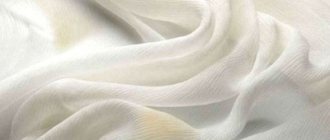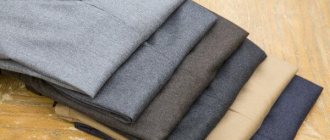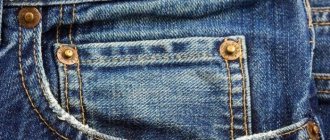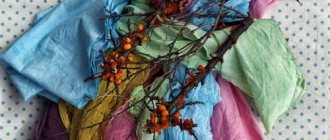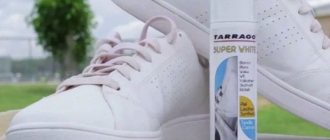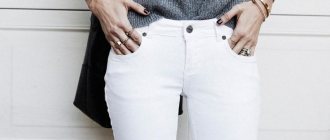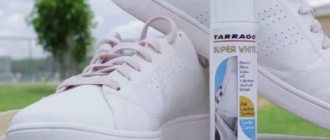Share on social media networks:
Nowadays, no wardrobe is complete without jeans, because they are the most comfortable and popular clothing. But it has one significant drawback: over time, jeans lose their original color and become faded. You can, of course, entrust your favorite pants or skirt to dry cleaning professionals, but this problem can be easily and simply solved on your own. You can return the color to its former brightness; a great idea is to dye your jeans in the washing machine. It's very simple and won't take much time or effort, plus it's absolutely safe for both your washing machine and your clothes. The main thing is to choose the right color. So, let's talk about how to dye clothes in the washing machine.
Painting products
Let's prepare the “tools” before painting. We will need:
- Jeans (be sure to wash them in advance without conditioner and dry them),
- Dye,
- Enameled deep container (pan, bucket, basin);
- Gloves. A chemical burn has never made anyone happy;
- Respirator. It is needed to avoid inhaling toxic fumes;
- Table salt, baking soda;
- Table vinegar.
Read the instructions for use carefully!
The second way is to use a washing machine.
- Prepare the coloring solution as in the previous version;
- Place jeans in washing machine;
- Pour the paint into the air conditioner compartment, or better yet, into the drum of the machine;
- Set the longest washing mode (t not lower than 90℃);
- Rinse the painted item in clean water;
- Fix the color with vinegar;
- We wash jeans as usual (t no higher than 40℃).
You can restore faded or faded dye on textiles at home or at a dry cleaner. Coloring things will help restore the previous shade or create a new one. If your white jeans have faded to a yellowish or gray color, they can be dyed or bleached.
You can dye textiles at home by hand or in a washing machine. Both of these methods are effective and extremely simple. Using the recommendations, you will cope with the task without much effort.
To work with textiles you will need:
- Dye;
- Household scales;
- Salt;
- Vinegar in an amount of 30 ml;
- Large metal container.
- The dyeing method depends on the dye that will be used. Using a scale, you need to determine the weight of the clothing in order to accurately calculate the proportion of the dye. The intensity of coloring and color fastness will depend on this.
- Vinegar and salt are used to fix the paint. These substances are dissolved in water and textiles are rinsed in them. The last rinse is carried out in cool water without additives.
- Many people are familiar with the situation when one colored sock can turn a dozen white things into a different color. An absurd problem was inspired by the method of household dyeing of clothes.
- The whole process can be divided into several stages:
- Prepare the product for painting. This could be pants or a jacket. It is important to pre-wash, remove stains if possible and remove decorative elements.
- Measure the weight of the clothes.
- Prepare the dye according to the instructions.
- Strain the prepared solution through cheesecloth or a fine sieve and pour into the drum or compartment for washing powder.
- Place clothes in the washing machine compartment. It is better to load items immediately after pre-washing. Damp fabric is easier to dye.
- Set the boiling program to 95 degrees.
- Set the timer for at least 30 minutes.
- At the end of the wash cycle, add salt to the drum and rinse. The amount of salt should correspond to the proportion: 1 cup per 1 kg of fabric.
- You can repeat the vinegar rinse and do a short wash without additives to lock in the dye and wash out any remaining dye that didn't take.
- Remaining pigment can be removed from the drum by dry washing with liquid bleach. The rubber seal should be wiped with a clean cloth.
If you want to restore the color of something dear to you or are not sure that you can cope with the task yourself, you can always turn to the services of professionals. This option has a number of advantages:
- Masters guarantee high-quality results.
- You can perform detailed color restoration in individual areas.
- Specialists will be able to radically change the color of the product and create a new shade.
- The salon has a wide selection of paints.
- Experienced craftsmen are familiar with the nuances of the textile industry, as well as the variety and properties of dyes. They have high-tech equipment and use advanced techniques. You will be warned about possible risks and the specifics of the work will be agreed upon.
- In addition, there are advantages in that you do not need to waste your time and effort working with the material. There is also no need to wash the surfaces of household items from the dye. Also in this case there will be no problems with finding a dye and selecting a shade.
Whether you want to bring old jeans back to life or give your favorite pants a more unique look, there are tons of dyes to choose from.
Ordinary acrylic paint will be useful for both professional artists and fashionistas to create a masterpiece from boring trousers. Nowadays it is quite easy to find any shades on the shelves, but if this is not enough, you can get a new one - the colors mix well.
Acrylic paints
The color should be applied with a brush onto pre-washed, dried and ironed material. It is better to draw the outlines of the design in advance with a pencil or fabric chalk so as not to get lost in the process. Thick cardboard should be placed inside the trouser leg so that the paint does not print on the other side.
Note! Although acrylic paint eats into the fibers quite deeply, with frequent washing the image will quickly lose its saturation, so it is not recommended to revive pants for everyday wear.
Drawing on jeans
When everything is ready, you need to let the acrylic dry. This may take 12-16 hours. Then the place where the paint is applied should be ironed so that the design lasts longer.
An excellent dye for denim fabric is based on aniline.
Aniline dyeing powders
Aniline powders withstand the effects of water and detergents well, so clothes dyed with their help are not afraid of washing.
Now liquid dyes based on aniline have appeared; they do not require dilution and are easier to use, but are less durable; such dyes are suitable for applying patterns and small designs.
Aniline dyed jeans
Interesting to know! If you mix aniline liquid dye with tragacanth glue in a ratio of 1:3, the composition will not spread. In addition, the design will fade less.
To return faded blue or black jeans to their original rich color, there is Dilon. The product is very convenient to use: it is simply added to the machine like washing powder. In addition to the coloring effect, Dilon also removes dirt. The effect of painting is quite long lasting.
Dilon palette
Although initially Dilon was produced in only two colors, today there is already plenty to choose from.
While some are trying to update their jeans by returning their color, others dream of making them old. In the USSR, denim jeans were popular, and fashion, as you know, is cyclical and tends to come back.
You can get this original effect using regular white.
White
Aerosol painting
It is unlikely that you will be able to achieve uniform painting with spray paint, but you can show your imagination and create fancy patterns. When using an aerosol, it is better not to disdain the stencil, otherwise you may catch excess fabric.
Not only a dye specifically for denim, but any available paint in a can will work well and last a long time.
Aerosol paints
A universal powder dye for fabric is perfect for jeans.
It is used economically, acts effectively, and does not spoil the structure of the fabric. Using it according to the instructions, achieving the desired result will not be difficult.
Universal powder dye
You can cheaply and cheerfully return the color to blue faded jeans by using bluing. The amount of dye is calculated depending on the desired shade. The product is diluted in warm salt water. The jeans are soaked in the resulting solution for several hours, sometimes “stirring” them and turning them over to get an even color. At the end, the pants are rinsed in a weak vinegar solution.
Blue for painting jeans
The main disadvantage of this method is that the results do not last long. After the first wash, the blue will begin to wash out.
Fabric paints
Almost any fabric dye will work for denim. They come in the form of powders, liquids and tablets.
Experimenters who are not tempted by proven and modern dyeing methods can turn to folk ingenuity. It is unlikely that high-quality uniform coloring can be achieved with the following options, but if someone is not afraid of unexpected results, why not try? After all, if methods exist, then someone needs it.
We suggest you read: How to remove salt from a dishwasher
Experimental methods of dyeing jeans
- Marker ink. To get paint, you need to dip the rods of a dozen or two felt-tip pens into water and leave until they turn completely white. Dip jeans into the resulting liquid and leave for a couple of hours. It is worth considering that the fabric should be much lighter than the felt-tip pens used.
- Natural dyes are also great for denim. Every food product contains pigment in greater or lesser quantities. If you choose bright vegetables, fruits, berries, herbs, seasonings, you can get an interesting result. Grind the selected ingredient and add water 1:2. Boil and let it brew for longer, the richer the desired color. Strain. Dilute 4 parts vinegar with 1 part dye, add ½ part salt. Boil the jeans in the resulting solution for an hour.
- Hair dye. For one pair of pants, take 2 packs of ammonia-free paint, dilute with water (it should be enough to completely cover the jeans, but no more). Soak the jeans for a couple of hours.
- Henna and coffee will give your jeans a brown color. Mix a pack of henna with 2 tbsp. ground coffee. Use in the same way as natural paints.
In order to begin the main process, you need to stock up on a couple of dyes. Depending on the desired result, there are situations in which you have to use several means at the same time. Such substances can be the popular potassium permanganate and blue, as well as acrylic paints or hair dyes. When choosing a dye, you should start from the real color that you would like to get.
Fabric paints
To achieve the best result, you must adhere to the following points:
- Turn the item to be painted inside out and simultaneously dilute the powder according to the instructions on the package.
- Place the jeans in the washing machine at the required temperature preset. Pour in powder for coloring; in some cases it is recommended to mix it with soda.
- Set the correct washing mode, often cotton or linen is used for these purposes, and run the wash without using fabric softener.
- After washing, the product must be thoroughly rinsed by hand in cold water, to which a small amount of vinegar should be added to fix only the resulting color.
- The final stage starts another wash for the shortest possible time, using regular washing powder. Afterwards, you need to thoroughly dry the item away from any heating devices that could spoil the even color.
- The jeans are turned inside out and zipped up.
- The clothes are placed in the washing machine.
- The prepared dye is poured into the drum.
- A mode is set for washing linen or cotton materials, and the water temperature should be 90-95 °C.
- If necessary, salt and vinegar are added to the drum.
- After painting, the remaining dye is washed out of the washing machine, and the painted item is dried naturally.
Painting by hand
Is it worth using an automatic car?
Yes. This will not affect the quality of further operation of the machine. For your own peace of mind, after finishing painting, wipe the drum and rubber seal SMA with a light cloth or paper towel.
If suddenly there are traces of pigment on them - this happens very rarely - activate the rinse mode. It is important to consider the weight of the product: when dry, one pair weighs 600-900 grams.
Process steps:
- The dye solution is poured into the drum (powder and laundry conditioner are not added).
- The prepared jeans (clean and rinsed) turned inside out are placed in the machine.
- If indicated in the instructions, pour a portion of ordinary kitchen salt into the drum, which acts as a pigment fixer in the fabric.
- Activate the “cotton” washing mode by selecting a combination with temperature, taking into account the recommendations on the item’s tag.
- The wrung out dyed jeans are immersed for 30 minutes in an acidic solution based on water and vinegar, diluted in a proportion of 1 spoon for every liter of liquid.
- After the fastening procedure, the jeans are washed in a machine, adding the usual portion of powder or gel. The mode chosen is the fastest and most gentle.
- Dry the item in the shade from the sun's rays, hanging it on a rope. We take into account the mass of the wet product.
Blue
How to dye jeans blue
First, let's figure it out - what's the best way to paint?
- powder paints,
- white,
- blue,
- potassium permanganate,
- acrylic paints,
- aerosols.
The bluing should be diluted with a small amount of water so that the liquid covers the fabric in the basin. Keep for a long time, you can leave it overnight, be sure to turn it over. After this, rinse the excess color well until the water runs clear. Soak, as standard, in vinegar.
This method does not bring a lasting, even, monochromatic result. The color will begin to fade after the first wash. And it will most likely stain your feet.
Enameled dishes, glass, and ceramic are suitable. In principle, at home you can use a bathtub or plastic buckets, but then you will have to wash them for a long time.
We repeat the same procedure with potassium permanganate. Such partial coloring looks beautiful on light-colored items. The shade depends on the concentration of manganese in the water (from pale pink to dark purple).
When dyeing black fabric, you have to restore the original shade, so only black dye is needed.
Fabric paint
Hardware stores sell fabric dyes. They have a powder structure and are used for painting in the washing machine.
- The powder is mixed with water in the proportion prescribed by the manufacturer.
- The jeans are turning inside out.
- The machine sets the temperature allowed for jeans.
- If the instructions for the paint do not indicate that it requires dilution, then it is poured into the drum onto the jeans that were previously placed there.
- Fabric softener is not added as it may alter the dyeing result.
- The machine is set to a mode for jeans; if it is not there, then a mode is selected, for example, for cotton or linen, at which the water temperature will be 80-90 °C.
- After washing is completed, the jeans are rinsed in cool water with a vinegar solution added to fix the color.
- After rinsing, the jeans are washed again on a short cycle with powder.
- Dry away from heating objects.
Hair dye
It is better to choose a natural dye without ammonia. On average, one pair of jeans takes two packs. The paint is diluted using the usual method according to the manufacturer's recommendations. Clothes are placed in a deep basin and completely filled with warm water in which the prepared paint is diluted. Jeans remain in the dyed mixture for 1.5-2 hours.
After soaking, rinse first in water at room temperature, and then in cold water with vinegar and salt. Then they are washed by machine with the addition of powder and dried in natural conditions.
The rods are removed from several black felt-tip pens and lowered into slightly cold water. When the water turns black, the jeans are immersed in it. After an hour, it is removed from the ink solution, washed with powder and dried.
They help not to re-dye jeans, but to decorate them. Aerosol paints are simply sprayed onto laid out clothes, and an arbitrary image is drawn with acrylics. Paint with a brush or the edge of a washcloth. The image is unique, but uneven. Additionally, you can use a stencil. To fix the acrylic, the jeans are placed between layers of white paper and ironed.
Blue
Sold in powder or solution form at any household. store. Clothes do not require boiling. It is enough to prepare a highly concentrated solution from chilled water, 1-2 tbsp. spoons of salt and blue. The jeans are kept in the solution for 1.5-2 hours; you can soak the clothes overnight. After soaking, rinse in a cold vinegar solution; you can soak for a quarter of an hour.
The blue washes out quickly, so painting will have to be repeated periodically.
Dylon
At the same time it is a denim dye and a detergent. Convenient, economical and easy to use. It is a powder, one package of which is enough to wash and dye half a kilogram of jeans.
When coloring, additional table salt is added to ensure color stability. Instructions for preparing the dye are indicated on the packaging. One packet of paint is enough to prepare a small bucket of solution. First, the powder is diluted in a small amount of water until completely dissolved, and then poured into the bulk.
It happens that your favorite item loses color during wear. Paints may be washed out by detergents during washing. To restore the shade and give a second life to jeans, there are several proven dyeing methods:
- Blue. The product helps to refresh the color of the fabric. The substance creates a short-term effect, so the event will have to be repeated periodically.
- Potassium permanganate. Used to achieve the “jeans-jeans” effect.
- Hair dye. Depending on the size of the product, you may need 1 or 2 packages.
- Felt-tip pens. You can use old felt-tip pens that don't write, but still have ink in them.
- Dry dyes for textiles with powder structure. Can be purchased at textile stores or points of sale of household chemicals and household goods.
- Acrylic paints for fabric. They contain thermal resins, so they are securely fixed after ironing. The product gives the fabric additional density. This fact must be taken into account.
- Aniline dyes for textiles. They come in liquid and powder form. The paints are easy to use. They do not stand out for their high durability.
- Stamp inks. Used for marking textiles. Withstands many washing cycles.
- Using the above compositions, you can not only restore the brightness of faded clothing, but also create an individual style using painting. Bored jeans or a jacket can be repainted in a radically new shade. For example, from white to black.
We suggest you read: Removing the smell of cat urine from carpets and furniture
To dye denim trousers, you need to follow the following sequence of steps:
- dilute the blue in water whose temperature is not lower than 30 degrees. Adjust the concentration of the solution depending on the desired result. To increase color fastness, you need to add a concentrate of 2 tablespoons of salt.
- Place the jeans in a bowl with the solution.
- For thorough dyeing, leave the pants in the solution for 2 hours. Turn the pants over periodically to ensure an even finish.
- Use a weak vinegar solution as a color fixer.
- Rinse the item thoroughly in cool water.
After drying, it is recommended to iron the clothes and can be worn.
If you can't find a special textile dye, try dyeing your jeans with hair dye. This method is especially good for black fabric. You can choose a shade from the following options:
- black;
- deep black;
- blue-black;
- black sapphire.
- It’s good if the composition does not contain ammonia. The coloring process is extremely simple:
- Prepare your jeans by removing any decorative embellishments.
- Dissolve the dye in warm water. Mix thoroughly.
- Place the pants or jacket in the bowl of solution.
- Leave for 60 minutes.
- Remove from solution.
- Rinse with salt and vinegar.
- Rinse one last time in cool, clean water.
- After dyeing is completed, dry the clothes and iron them. The item is ready to wear.
To freshen up a jacket or change its tone, you need to follow certain rules. Otherwise, the result may not be exactly what you expect. Here are the main recommendations:
- You need to remove all removable parts: hood, collar, fur or cuffs.
- Carefully remove the buttons;
- Check pockets and empty them;
- Fasten the zippers.
- If necessary, wash the jacket and remove stains.
- Next, color according to the instructions for the type of dye you are using.
- Calculate the components taking into account the weight of the product.
- After dyeing, rinse with salt and vinegar.
- Do not spin. If necessary, remove excess moisture with a dry cloth.
After drying, sew the buttons back and return the additional elements to their original places.
If your favorite cotton pants have faded and lost their attractiveness, you can restore them to their former beauty using aniline dye or any dye that can be used for this type of fabric.
Let's take a closer look at what actions need to be performed:
- Decide on the shade and type of dye.
- Prepare the product for use. Remove buckles, buttons and decorative hardware. Empty your pockets. Pre-clean the fabric.
- Moisten the material to improve the dyeing result.
- Paint the item according to the dye manufacturer's instructions.
- Record the result using saline and vinegar solutions.
- Rinse thoroughly in clean water.
If necessary, repeat the procedure periodically so that the color of the textile product is always bright.
If you have used markers with ink left over, use them to color your pants. The method is especially effective for highlighting material. How to do it:
- Remove the rods from the housing and place them in a container of water.
- Wait a while.
- When the water turns black, place your pants in it, after removing the rods.
- Soak the clothes in the solution for at least an hour.
- Turn the fabric over periodically.
- Rinse in vinegar and salt concentrate and then in clean water.
This simple and non-standard method will help restore the former color of your favorite clothes.
Care after coloring
Most fabric dyes have good resistance to external influences, so you don’t have to worry about washing. However, you should not be overzealous with the duration and temperature conditions of the cycle. It is better to opt for hand washing at a temperature of no higher than 40 degrees.
After finishing washing, the product is usually placed in a basin with diluted vinegar and table salt. This composition helps to maintain the result for a long time.
How to properly dye jeans using Blue and potassium permanganate?
The choice of powder formulations is huge. They are easy to use and highly durable. Price category from 20 rubles per package.
Manufacturers of more expensive modern dyes have eliminated this shortcoming, and we can afford bright shades.
Dissolve a packet of coloring powder in 0.5 liters of water, in a separate container (glass, ceramics) with warm water, stir thoroughly.
Strain the solution. To do this, you can use: a piece of old organza, tulle, gauze, cotton wool, which will hold undissolved particles.
Place clothes, prepared solution in a large saucepan and add water so that the liquid covers the pants.
Add salt or soda if the instructions require it. Bring to a boil and keep on fire for an hour.
Don't forget to stir and turn over. Otherwise the color will lie unevenly.
Leave the jeans to cool in the dye. Wash in warm, then cold water.
We fix the result with vinegar for at least 30 minutes. Fixative: vinegar 9% (3 tbsp per 1 liter of water) or vinegar essence 70% (2 tbsp per 1 liter of water).
Whiteness helps solve several problems at once:
- Complete whitening
- Lightening by tone,
- Partial (amber, spotted patterns),
- The "varenki" effect.
Depending on what kind of lightening we are trying to achieve, we keep the item in an aqueous solution of whiteness for 10 minutes to 1 hour.
If you partially dip the clothes into white, for example, only from the bottom, we get a color transition effect (ombre). Tie several strong knots on the legs and after processing, an unusual ornament will appear.
Our parents independently “cooked” cool jeans with whiteness, which became a cult attribute of the 80s and early 90s.
Coloring depends on your wishes. If you need deep blacks, use high-quality powder dyes; if you need dark grays, lighten them with white.
Dyes that can be purchased to change or restore the shade of jeans can be divided according to the following parameters:
- composition;
- structure;
- packaging;
- origin;
- purpose.
- The composition of textile dyes is varied. The components contained in the substance affect its durability and brightness. Some elements are capable of changing or transforming the structure of the fabric to which they are applied. For example, acrylic gives the canvas additional strength and density.
- The structure or form of release of the dye is responsible for the method of its application. There are three main types:
- powder;
- liquid;
- aerosol;
- pasty suspension;
- natural look.
- The packaging of the paint ensures shelf life and ease of application. It can be paper, polyethylene, in the form of a tube, balloon or jar.
- By nature, dyes can be divided into two main groups:
- Natural. An environmentally friendly method of dyeing textiles using plant and food ingredients. They are often used in their natural form, as well as in the form of juices and decoctions.
- Synthetic. Elements obtained by chemical means. They are often extracted during the technological processing of various substances using the production method.
- Depending on the purpose, the paint can be applied with a brush to local areas or evenly distributed over the entire surface of the canvas.
- The choice of dye depends on the goals and needs of the person.
The simple and affordable composition is ideal for restoring the color of classic denim items. The drug is available for purchase in hardware stores. Please read the instructions carefully before use.
Please note that the substance is suitable for tinting blue items. It will not be possible to completely change the shade with this help. The durability of the bluing is not high, so after a while you will have to repeat the procedure.
Another point that cannot be neglected is that during the washing process after dyeing, the pigments from the fabric will be washed out, so it is better to wash the item separately from others or with clothes of the same color.
To make the result last longer, dyed jeans require careful care.
It is better to wash your pants by hand, in warm but not hot water. Preference should be given to laundry soap or soap nuts rather than aggressive powders. Before washing, jeans should be turned inside out.
We invite you to read: Planting grape cuttings for the winter
Important! Dyed jeans should be washed separately from other items.
The product should not be pre-soaked - the color will come off along with the dirt.
Under no circumstances should you dry your jeans in direct sunlight, as this will cause the color to fade. Leaving clothes on a radiator runs the risk of yellow stains and dull colors. Drying on clotheslines in a well-ventilated area is suitable.
By following these simple recommendations, you can dye your jeans at home and enjoy the rich colors for a long time.
- you can create fuzzy, blurry boundaries of color transitions with aniline;
- to fix the dye, tragacanth glue is added to the aniline in a ratio of 1:3, or the jeans can be pre-soaked in gelatin;
- Any drawing is created with acrylic-based paints. They are applied to a dry item along pre-drawn contours. The paint dries for 10-15 hours, and then the jeans are smoothed with an iron.
They are more often used in screen printing, but for manual work there is a fluorescent dye based on a phosphor.
- Jeans are cleaned of dirt and washed.
- The first layer of the image is applied with a synthetic brush.
- After the first layer has completely dried, the second and subsequent layers are applied.
- After applying the last layer, the jeans dry for 2-3 hours.
To make the drawing look more impressive, light colors are used as a basis. The glow dye is charged from sunlight, which accumulates in 20-30 minutes.
Fabric paints
Hair dye
This method is a little unusual, but it gives excellent results when painting at home, the shade is bright and very saturated. To achieve the desired result, you need to prepare 2 packages of hair dye of the selected shade. The paint is diluted in the standard way and added to a basin of water; it is important that the liquid completely covers the item being painted.
The denim item must be left in the solution for two hours for best dyeing. After completing this process, the jeans must be rinsed in water at room temperature for the first time, and the second time in cool water with the addition of salt and vinegar. Be sure to wash your jeans in the washing machine using regular powder without bleaching. Dry the product in a well-ventilated area.
Blue
To achieve high-quality blue dyeing at home, you should follow the following key steps:
- Blue must be diluted in cold water, after which it can be mixed with warm water. You should act strictly according to the instructions; some of the product works during the washing process, and the other during rinsing.
- Pre-washed and ironed jeans are dipped into the solution; if the product is wrinkled, the coloring will be uneven. The process should be smooth, with the jeans slowly immersed in the prepared solution to obtain an even color.
- Depending on the brightness of the required shade, the jeans remain in the solution from 2 to 12 hours; with the maximum time, an extremely saturated shade of blue is obtained.
- Finally, the product must be rinsed several times, changing the water each time; vinegar is added to the latter to fix it.
White
Such a product can be classified not so much as coloring, but rather as lightening the product. For several decades, whiteness was used to produce fashionable “varenok”; with its help, the effect of a faded bluish tint appeared on the product.
Jeans of this color can be obtained by following the following algorithm:
- In 10 liters of water you need to dilute 250 ml of white, which can be purchased at any hardware store.
- Place the jeans in a fully immersed bucket and boil for about 15-20 minutes depending on the thickness of the fabric.
- During the entire process, it is necessary to prevent the jeans from rising above the surface of the water and be sure to carry out all painting work in a well-ventilated area.
In order to change the color of your favorite jeans, you need to choose the optimal dyeing method, depending on the dye itself and the desired result. Jeans can not only be completely dyed, but also use unusual techniques that will give the product an original appearance; these options include coloring, which looks especially good on white jeans. To achieve the desired result, the following two methods are mainly used.
Washing machine
To avoid such consequences, you must carefully read the instructions on the packaging of coloring components and do not increase the recommended percentage of dye.
- The item being prepared for dyeing must first be washed and dried, this will help the color to lie most evenly.
- Dilute the coloring composition in water if the instructions require it and be sure to get rid of any lumps from the powder products.
- Select the maximum temperature allowed for denim and run the wash cycle for a longer duration. The solution, depending on the recommendations, is poured either directly into the drum or into a special compartment.
- After washing, immerse the dyed jeans in salted water for half an hour, then run an additional wash as usual. This procedure will help get rid of excess dye and make the color more even.
- After finishing the washing machine, you must carefully inspect the parts for staining and, if necessary, treat them with laundry soap. Otherwise, there is a high probability of things staining during subsequent washes.
Methods for dyeing denim
Washing machine
Hand dyeing
This method is especially convenient for coloring, in which you need to control the brightness of the color, as well as create interesting transitions from the brightest shade to the lightest. However, only enamel dishes can be used for this method.
- First, the dye is prepared and diluted in the required quantity in a separate container.
- The paint is mixed with water from 7 to 10 liters, depending on the volume of the product, and the liquid is heated on the stove almost to a boil.
- Jeans are already dipped into hot water and boiled for about an hour.
- The item is rinsed alternately in hot and cold water; during the last rinse, vinegar is added to fix the resulting shade.
- Finally, the dyed jeans are washed optimally in the machine, with the addition of softening agents.
After using any coloring agents, it is necessary to ensure proper care of the updated item. Despite the color being fixed at first, it can change for the worse due to many factors, incorrect washing or ironing mode, or improper drying.
To maintain the desired color, you must follow a few simple rules:
- For the first few washes, wash dyed jeans separately from other items, and do not use them at high temperatures.
- Eliminate treatment with laundry soap, use of conditioners and use the powder only for colored laundry
- Do not dry jeans in direct sunlight or on heating appliances
If you follow these simple rules, the painted item will not change its color and will last much longer.
Photo tips on how to dye jeans
- Take care in advance to protect the work area from dye ingress. Cover the surface with a protective layer of polyethylene or thick paper.
- Use gloves to protect your hands.
- If you cannot remove stains from clothes, you need to choose dark colors for dyeing.
- To prepare the fixing composition, use 30 ml of vinegar per 3 liters of water.
- When using the manual cleaning method, it is important to thoroughly mix the clothes in water to ensure an even color.
- Consider the original color of the fabric. To change the shade dramatically, pre-bleaching may be required.
Having studied the options for using textile dyes and the range, you can easily return the color of a worn item or create an exclusive option for your wardrobe. You can experiment with dye components and come up with your own options. As a last resort, you can always contact a dry cleaner to rectify the situation and receive qualified assistance from specialists.
Before staining
Activities to update trousers will not cause any trouble if you follow all the technical recommendations for conducting the process:
- Before dyeing, the product is washed, then the fabric is inspected for streaks and stains;
- all pockets are checked - nothing should be in them;
- It is worth carefully examining the label on the inside of the trousers - perhaps dyeing with a washing machine is not suitable for them;
- Dye manufacturers provide important information on the packaging, so you should also read their instructions.
